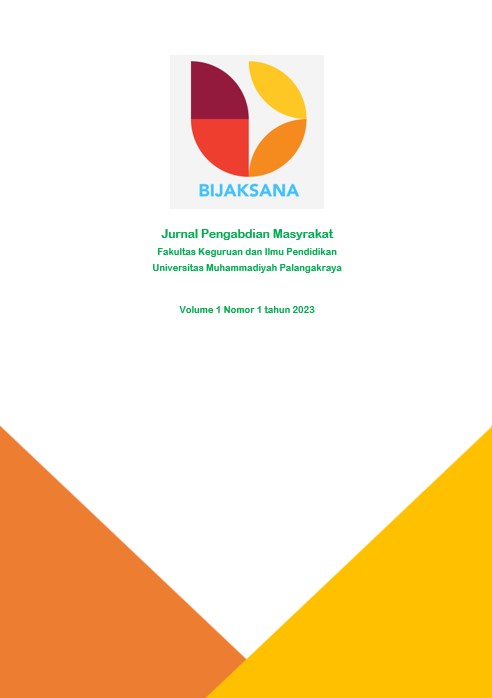Penerapan 5 Kriteria Guru Dalam Optimalisasi Pembelajaran Online Era Coronavirus Di SMK Karsa Mulya Palangka Raya
Main Article Content
Abstract
Pembelajaran online tidak selalu berjalan sesuai dengan yang direncanakan sebelumnya. Ada banyak hal yang membuat pembelajaran online kurang optimal. Tidak terkecuali dengan sekolah di SMK Karsa Mulya Palangka Raya. Ada sejumlah penggunaan teknologi di SMK Karsa Mulya Palangka Raya yang tersedia untuk pendidikan online tetapi terkadang hal itu menimbulkan banyak kesulitan. Kesulitan dan masalah yang terkait dengan teknologi modern ini berkisar dari kesalahan pengunduhan, masalah penginstalan, masalah login, masalah dengan audio dan video, dan sebagainya. Terkadang siswa menganggap pengajaran online membosankan dan tidak menarik. Solusi yang ditawarkan adalah 5 kriteria yang bisa diterapkan sebagai pertimbangan utama yang penting saat menyampaikan pembelajaran online. Kriteria-kriteria tersebut adalah instruksi, konten, motivasi, relasi, dan kesehatan mental. Metode pelaksanaan pengabdian masyarakat ini menggunakan metode dan prosedur teknik penguasaan konten. Teknik penguasaan konten adalah Teknik yang berupa bantuan kepada individu (sendiri dan kelompok) untuk menguasai kemampuan atau kompetensi tertentu melalui proses belajar. Dengan teknik penguasaan konten dapat membantu individu menguasai aspek-aspek konten tersebut secara tersinergikan. Dengan penguasaan konten, individu diharapkan mampu memenuhi kebutuhannya serta mengatasi masalah-masalah yang dihadapinya. Dalam hal ini konten yang harus dikuasai adalah penguasaan dalam melakukan proses pembelajaran online dengan penerapan 5 kriteria guru. Hasil pengabdian menunjukan bahwa penerapan 5 kriteria bagi guru memberikan efek positif terhadap perubahan dalam pembelajaran yang dilakukan oleh guru. Peserta didik menjadi lebih aktif dan pembelajaran lebih optimal.
Downloads
Article Details
Authors who publish with this journal agree to the following terms:
- Any article on the copyright is retained by the author(s).
- The author grants the journal, right of first publication with the work simultaneously licensed under a Creative Commons Attribution License that allows others to share work with an acknowledgment of the work authors and initial publications in this journal.
- Authors are able to enter into separate, additional contractual arrangements for the non-exclusive distribution of published articles of work (eg, post-institutional repository) or publish it in a book, with acknowledgment of its initial publication in this journal.
- Authors are permitted and encouraged to post their work online (e.g., in institutional repositories or on their websites) prior to and during the submission process, as can lead to productive exchanges, as well as earlier and greater citation of published work.
- The article and any associated published material is distributed under the Creative Commons Attribution-ShareAlike 4.0 International License
References
Basilaia, G, M Dgebuadze, M Kantaria, and G Chokhonelidze. (2020). Replacing the Classic Learning Form at Universities as an Immediate Response To the Covid-19 Virus Infection in Georgia. International Journal For Research in Applied Science & Engineering Technology Vol. 8 (III).
Carey, K. (2020). Is Everybody Ready For The Big Migration To Online College? Actually, No. Newyork. The New York Times.
Cojocariu, V M, I Lazar, V Nedeff, and G Lazar. (2014). SWOT Analysis OF E-Learning Educational Service From the Perspective of Their Beneficiaries. Procedia-Social and Behavioral Sciences Vol. 116, 1999-2003.
Dhawan, Shivangi. (2020). Online Learning: A Panacea in the Time of Covid-19 Crisis. Journal of Education Technology Systems (SAGE) Vol. 49 (1) 5-22.
Keeton, M. T. (2004). Best Online Instructional Practice: Report of Phase I of an Ongoing Study. Journal of Asynchronous Learning Networks Vol. 8(2): 75-100.
Kim, K -J, and C J Bonk. (2006). The Future of Online Teaching and Learning in Higher Education: The Survey Says. Educause Quarterly Vol. 4 : 22-30.
Littlefield, J. (2018). The Difference Between Synchronous and Asynchronous Distance Learning.
McBrien, J L, R Cheng, and P Jones. (2009). Virtual Spaces: Employing a Synchronous Online Classroom to Facilitate Student Engagement in Online Learning. The International Review of Research in Open and Distributed Learning Vol 10 (3), 1-17.
Parkes, M, S Stein, and C Reading. (2014). Student Preparedness For University e-Learning Environments." The Internet and Higher Education Vol. 25: P. 1-10.
Rieley, J. B. (2020). Corona Virus and Its Impact on Higher Education." Research Gate.
Singh, V, and A Thurman. (2019). How Many Ways Can We Define Online Learning? A Systematic Literature Review of Definitions of Online Learning (1988-2018). American Journal of Distance Education Vol. 33(4), 289-306.
Song, L, E S Singleton, J R Hill, and M H Koh. (2004). Improving Online Learning: Student Perceptions Of Useful and Challenging Characteristics. The Internet and Higher Education Vol 7(1): P. 59-70

